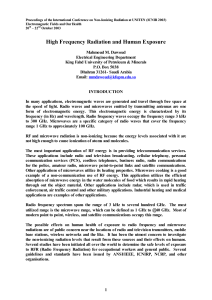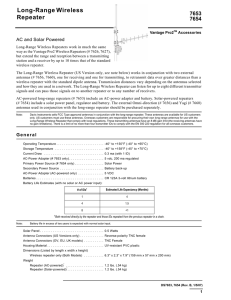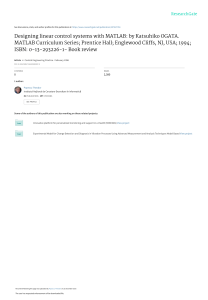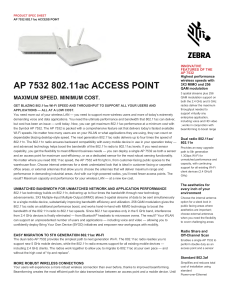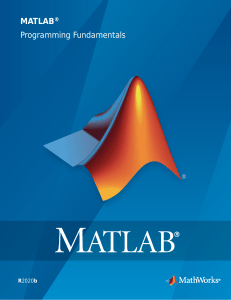ART para desarrollar tomogramas en Matlab ART to develop
Anuncio
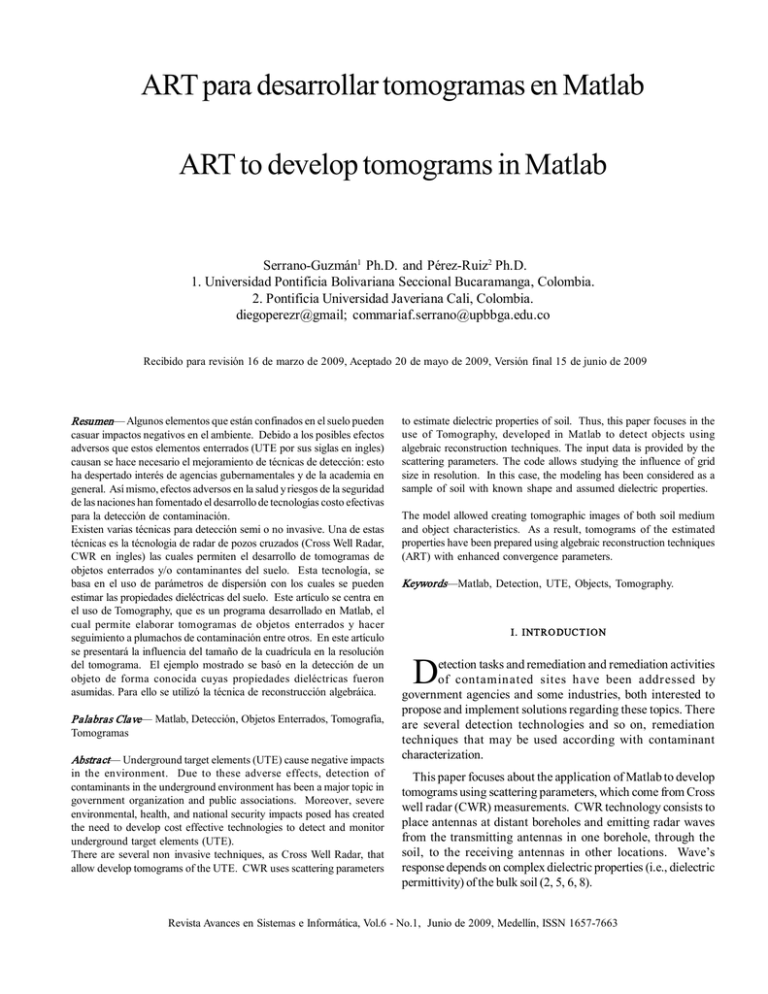
ART para desarrollar tomogramas en Matlab ART to develop tomograms in Matlab Serrano­Guzmán 1 Ph.D. and Pérez­Ruiz 2 Ph.D. 1. Universidad Pontificia Bolivariana Seccional Bucaramanga, Colombia. 2. Pontificia Universidad Javeriana Cali, Colombia. diegoperezr@gmail; commariaf.serrano@upbbga.edu.co Recibido para revisión 16 de marzo de 2009, Aceptado 20 de mayo de 2009, Versión final 15 de junio de 2009 Resumen — Algunos elementos que están confinados en el suelo pueden casuar impactos negativos en el ambiente. Debido a los posibles efectos adversos que estos elementos enterrados (UTE por sus siglas en ingles) causan se hace necesario el mejoramiento de técnicas de detección: esto ha despertado interés de agencias gubernamentales y de la academia en general. Así mismo, efectos adversos en la salud y riesgos de la seguridad de las naciones han fomentado el desarrollo de tecnologías costo efectivas para la detección de contaminación. Existen varias técnicas para detección semi o no invasive. Una de estas técnicas es la técnologia de radar de pozos cruzados (Cross Well Radar, CWR en ingles) las cuales permiten el desarrollo de tomogramas de objetos enterrados y/o contaminantes del suelo. Esta tecnología, se basa en el uso de parámetros de dispersión con los cuales se pueden estimar las propiedades dieléctricas del suelo. Este artículo se centra en el uso de Tomography, que es un programa desarrollado en Matlab, el cual permite elaborar tomogramas de objetos enterrados y hacer seguimiento a plumachos de contaminación entre otros. En este artículo se presentará la influencia del tamaño de la cuadrícula en la resolución del tomograma. El ejemplo mostrado se basó en la detección de un objeto de forma conocida cuyas propiedades dieléctricas fueron asumidas. Para ello se utilizó la técnica de reconstrucción algebráica. Palabras Clave— Matlab, Detección, Objetos Enterrados, Tomografía, Tomogramas Abstract— Underground target elements (UTE) cause negative impacts in the environment. Due to these adverse effects, detection of contaminants in the underground environment has been a major topic in government organization and public associations. Moreover, severe environmental, health, and national security impacts posed has created the need to develop cost effective technologies to detect and monitor underground target elements (UTE). There are several non invasive techniques, as Cross Well Radar, that allow develop tomograms of the UTE. CWR uses scattering parameters to estimate dielectric properties of soil. Thus, this paper focuses in the use of Tomography, developed in Matlab to detect objects using algebraic reconstruction techniques. The input data is provided by the scattering parameters. The code allows studying the influence of grid size in resolution. In this case, the modeling has been considered as a sample of soil with known shape and assumed dielectric properties. The model allowed creating tomographic images of both soil medium and object characteristics. As a result, tomograms of the estimated properties have been prepared using algebraic reconstruction techniques (ART) with enhanced convergence parameters. Keywords—Matlab, Detection, UTE, Objects, Tomography. I. INTRO DUCT ION D etection tasks and remediation and remediation activities of contaminated sites have been addressed by government agencies and some industries, both interested to propose and implement solutions regarding these topics. There are several detection technologies and so on, remediation techniques that may be used according with contaminant characterization. This paper focuses about the application of Matlab to develop tomograms using scattering parameters, which come from Cross well radar (CWR) measurements. CWR technology consists to place antennas at distant boreholes and emitting radar waves from the transmitting antennas in one borehole, through the soil, to the receiving antennas in other locations. Wave’s response depends on complex dielectric properties (i.e., dielectric permittivity) of the bulk soil (2, 5, 6, 8). Revista Avances en Sistemas e Informática, Vol.6 ­ No.1, Junio de 2009, Medellín, ISSN 1657­7663 Revista Avances en Sistemas e Informática, Vol.6 ­ No.1, Junio de 2009, Medellín, ISSN 1657­7663 78 Dielectric properties, like that, depend on soil type, moisture content, temperature (1), and the presence of water, chemical and objects (9, 10). It is significant difference in dielectric properties of materials in the environment. Because of that, air, water, Dense Non Aqueous Phase Liquids (DNAPLs), and other potential targets (e.g. landmines) differ significantly from each other, and the presence of disturbances in the soil medium causes differences in the wave propagation properties of the bulk soil (3, 9, 10). The propagation of EM waves in subsurface environments can be assessed by measuring scattering parameters (S­ Parameters), and estimating the transmission (Ô) and reflection (Ã) coefficients of the bulk media along a raypath. These coefficients are related to the dielectric permittivity (år) and permeability (µr) through equations 1 and 2: G = m r -1 e r Equation 1 m r + 1 e r w T = exp( -i w me d = exp( -i m r e r d ) Equation 2 c The general goal of this paper is to create tomograms of UTE using Matlab. Some specific objectives addressed are: • Model detection of an object with known dimensions • Develop tomograms of the soil and its spatial characteristics using different grid distributions. II. TOM OGRAM S DEVELOPM ENT METHODOLOGY Tomograms are prepared using the permittivity estimates of all raypaths between transmitting and receiving antennas. Tomographic images of estimated dielectric permittivity are developed using algebraic reconstruction techniques (ART). ART is an iterative method which reconstructs an object by a sequence of alternating projections and correcting back projections (7). In this method an initial “guessed” projection is made, checked against measured data, and corrected until results are satisfactory. Simultaneous ART corrects the projection after the whole object (antenna array) has been projected (7). The basic aim of ART is to image a material parameter f(x,y) (e.g., permittivity) from line­integral data g k collected for R k signal paths (Equation 3): where i= ­1, c is velocity of light in free space, d is separation of the antennas, and ù is the angular frequency. g k = ò f(x, y)ds Scattering parameters measured in several raypaths within an arrangement of transmitting and receiving antennas (Figure 1) are applied to create tomograms of the soil and its characteristics. where ds represents a cell­weighting factor expressing the influence of the property in the ij pixel on the K ray. In our case, it corresponds to the length of the ray segment in the specific cell ij. Equation 3 R k The algorithm for reconstruction begins with an initial estimate of material parameter f 0ij for every pixel in a Cartesian grid and L estimates the projection value g Λ I J q g = åå f ij Δs ijk i (Equation 4): Equation 4 j where fq ij indicates the estimated image after q th iteration and represents the average value of f(x,y) on the cell (i,j), and Äs ijk is the length of a ray segment that intercepts the pixel. Iterations are evaluated until the difference errors between measured and estimated values are minimized. Measured values on our system represent the travel time (t r ) along each ray path. The estimated material parameters represent the wave slowness (p) properties of the material along corresponding raypath (Equation 5): Figur e 1. Ray­path incidence and borehole distribution associated with a CWR tomography I J t r = åå p ij Δs ijk i j Equation 5 ART para desarrollar tomogramas en Matlab – Serrano­Guzmán y Pérez­Ruiz The wave slowness is the inverse of wave velocity and is related to the relative dielectric permittivity (år) and the vacuum velocity (c=0.3mns­1) (Equation 6): ε 1 p » = r v c Equation 6 Normally, CWR uses multiple measurements m k , thus, the matrix form can be expressed in matrix forms including many different ray paths (1 k K) as: M=D •S Equation 7 where M is a K vector of projection estimated values, D is the projection matrix (K*N; N= number of projections), and S is an N vector of the unknown material parameter. The unknown parameter is solved iteratively for a pixel J=1:N using Equation 8: r r r r S × D - M r S j = S ( j - 1 ) + l ( j -1 r) r T D D × D Equation 8 Where, λ is the relaxation parameter. This factor provides convergent solutions through the iterative procedure (4). A. Detection Using ART The TOMOGRAPHY code has been developed in Matlab to locate and estimate the shape of a simulated squared target element buried underground. The squared target element is assumed to have a constant permittivity of 4. The background permittivity (e.g., 2 ) has been assumed spatially constant (i.e., constant velocity). The simulation is done considering a setup with 30 cm*30 cm and a lateral array of 5 antennas in each side of the setup. In addition, a simulation of 10 antennas in each side of the setup with 2.5 cm of separation between antennas has been run. The developed code allows determining the required number of antennas to get a better resolution in tomogram according with the geometry of the system and with the size of the target. By the other hand, once the better arrangement of antennas is chosen, simulations are done using 5* 5 or 7*5 grid sizes. The raypaths used were traced through the target and 0.1, 0.2, and 0.5 are used as relaxation factor. The flow chart (Figure 2) shows the input data procedure that is used in Tomography. Figur e 2. Input data flow chart 79 80 Revista Avances en Sistemas e Informática, Vol.6 ­ No.1, Junio de 2009, Medellín, ISSN 1657­7663 III. RESULTS TOMOGRAPHY code allowed determining the location of a square object using grids of 5*5 and 7*5 with two different antenna arrays (Figure 3 to 6). Higher density of antenna’s raypath improves the detection of the UTE as tomograms shown; nevertheless, when radar measurements are used, coupling of antennas must be considered in addition to the best resolution in tomograms. Tomograms have been produce changing the value of relaxation factors. It is notoriously the better resolution that has a grid size of 5*5 (Figure 3 and 5) over 7* 5 (Figure 4 and 6), even using the same relaxation parameter (Figure 3a and 4a, 3b and 4b, and 3c and 4c for 5 antenna array, and Figure 5a and 6a, 5b and 6b, and 5c and 6c for 10 antenna array). Moreover, λ’s values higher than 0.5 did not improve the tomogram resolution in any case. Figur e 3. a) 5*5 with λ=0.1 The tomograms developed using a size grid of 7*5 shown “noise” that may be explained by the increasing in size grid distribution at the horizontal axis that causes new assumptions in the iteration process. Moreover, the resolution did not improve notoriously when relaxation parameter changed. I V. C O NC L USI O NS A Tomography code has been developed in Matlab to create tomographic images of UTE with a known relative permittivity value. Permittivity value has been assumed in each raypath of antennas arrangement. The code used algebraic reconstruction technique (ART) to develop the tomographic images The code assumes straight raypaths, and may loose resolution when raypaths are bent due to spatially varying velocity profiles. These tomograms may be used to image and visualize the presence of disturbances in a medium. Figur e 3. b) 5*5 with λ=0.2 Tomography code generates acceptable tomograms of UTEs in soils, provided that there is sufficient density of antennas arrays, and proper grid spacing. The code, thus, provides an excellent tool for optimal detection using electromagnetic non­ invasive techniques as cross well radar and can be applied to determine the number of antennas required for good resolution of a specific geometry in lossless medium. Simulations of squared UTE using the code indicate that an array of 5 antennas, spaced 5 cm each one, on the lateral side of a 2D set up shown good resolution for detection. Figur e 3. c) 5*5 with λ=0.5 ART para desarrollar tomogramas en Matlab – Serrano­Guzmán y Pérez­Ruiz Figur e 4. a) 7*5 with λ=0.1 Figur e 5. a) 5*5 with λ=0.1, 10 antennas Figur e 4. b) 7*5 with λ=0.2 Figur e 5. b) 5*5 with λ=0.2, 10 antennas Figur e 4. c) 7*5 with λ=0.5 Figur e 5. c) 5*5 with λ=0.5, 10 antennas 81 82 Revista Avances en Sistemas e Informática, Vol.6 ­ No.1, Junio de 2009, Medellín, ISSN 1657­7663 An increasing in antennas number improved the resolution of the tomogram; nevertheless, coupling of antennas must be considered for field application. The accuracy using a size grid of 7*5 did not enhance the resolution in any cases analyzed. It is deduced that better tomographic results may be achieved for a 5*5 size grid. The code may be therefore be used to optimize the number and distribution of antennas required for the development of a field setup. ACK NO WL E DGM E NT S Thanks to M.Sc.. Marcelino Vazques and M.Sc. Lucrecia Molano at Mayaguez, Puerto Rico. Figur e 6. a) 7*5 with λ=0.1, 10 antennas Figur e 6. b) 7*5 with λ=0.2, 10 antennas Figur e 6. c) 7*5 with λ=0.5, 10 antennas REFERENCES [1]Antonyk N.A., I.S. Kruglov, L.P. Ligthart, V.V. Zagoskin, A.S. Shostak, and V.N. Iljushenko, 2004. Measurement of the Complex Dielectric Permittivity of Stratified Media with Dipole Antenna Sensors, European Radar Conference, Amsterdam. [2]Dong­Ho H. and Yuand­Liand Li, 2001. Complex Dielectric Constant Measurement techniques for High­Speed Signaling, IEEE. [3]Farid, M., 2004. DNAPL Detection Using Cross Well Radar, PhD. Dissertation, Northeastern University, Boston. [4]Fujiwara K., T. Nakata, T. Okamoto, N., K. Muramatsu, 1993. Transactions on Magnetics IEEE, Volume 29 (2), pp 1962­1965. [5]Hallikainen M. T., M.C. Dobson, and L. Wu, 1985. Microwave Dielectric Behavior of Wet Soil­Part I: Empirical Models and Experimental Observations, IEEE Transactions on Geoscience and Remote Sensing, vol. 23, no. 1, pp. 25­34. [6]Hoekstra P. and A. Delaney, 1974. Dielectric Properties of Soils at UHF and Microwave Frequencies, Journal of Geophysical Research 10 . [7]Mueller K. and R. Yagel, 1999. On the Use of Graphics Hardware to Accelerate Algebraic Reconstruction Methods, SPIE Medical Imaging Conference 1999, Physics of Medical Imaging, San Diego. [8]Sarabandi K., and F. T. Ulaby, 1988. Technique for Measuring the Dielectric Constant of Thin Materials, IEEE Transactions on Instrumentation and Measurement, vol. 37, no. 4, pp. 631­636. [9]Serrano­Guzman Maria F., 2008. Detection and monitoring of DNAPLs in the subsurface under transient conditions using Cross Well Radar, , PhD. Dissertation, University of Puerto Rico, Mayaguez Campus. [10]Serrano­Guzman Maria F., Padilla I., and R. Rodriguez, 2006. Two­ Dimensional Detection of Underground Contamination and Buried Objects Using Cross­Well Radar, Proc. of SPIE Vol. 6210 62100R­ 1, Orlando. ART para desarrollar tomogramas en Matlab – Serrano­Guzmán y Pérez­Ruiz M .F. Ser r ano­Guzmán. Civil Engineering, Graduate studies in Building construction at Universidad Industrial de Santander, Graduated studies in Environmental Engineering at Universidad Pontificia Bolivariana Seccional Bucaramanga, Master Engineering at University of Puerto Rico at Mayaguez, PhD. In Civil Engineering at University of Puerto Rico of Mayaguez). Dean of Research in Universidad Pontificia Bolivariana at Bucaramanga. D.D. Pér ez­R uíz (Civil Engineering, Master in Transit and Transport Engineering at Universidad del Cauca, Master in Science at University of Puerto Rico at Mayaguez, PhD in civil Engineering at University of Texas at Arlington. Associated professor at Pontificia Universidad Javeriana at cali. 83 84 Revista Avances en Sistemas e Informática, Vol.6 ­ No.1, Junio de 2009, Medellín, ISSN 1657­7663 Universidad Nacional de Colombia Sede Medellín Facultad de Minas Escuela de Ingeniería de Sistemas Misión La misión de la Escuela de Ingeniería de Sistemas es fomentar y apoyar la generación o la apropiación de conocimiento, la innovación y el desarrollo tecnológico en el área de ingeniería de sistemas e informática sobre una base científica, tecnológica, ética y humanística. Visión La formación integral de profesionales desde el punto de vista científico, tecnológico y social que les permita adoptar, aplicar e innovar conocimiento en el campo de los sistemas e informática en sus diferentes aspectos, aportando con su organización, estructuración, gestión, planeación, modelamiento, desarrollo, procesamiento, validación, transferencia y comunicación; para lograr un desempeño profesional, investigativo y académico que contribuya al desarrollo social, económico, científico y tecnológico del país. Escuela de Ingeniería de Sistemas Dirección Postal: Carrera 80 No. 65 ­ 223 Bloque M8A Facultad de Minas. Medellín ­ Colombia Tel: (574) 4255350 Fax: (574) 4255365 Email: esistema@unalmed.edu.co http://pisis.unalmed.edu.co/
